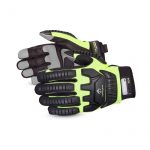Archive for 2019
OSHA 1910.136(a): Foot Protection
History: As part of the rules and regulations regarding workplace safety, the Occupational Safety & Health Administration (OSHA) requires protective footwear for workers in industrial settings. Occupational foot protection is included in the Personal Protective Equipment (PPE) section of the Occupational Safety and Health Standards, specifically 29 CFR 1910.136. The existing OSHA standards for PPE…
Read MoreOSHA 1910: 1200—HazCom Standard
History: OSHA refers to this Hazard Communication Standard (HCS) as the one “that gave workers the right to know now gives them the right to understand.” To be specific: On March 26, 2012, OSHA amended the 1983 hazard communication standard to align with the Globally Harmonized System for the Classification and Labelling of Chemicals (GHS).…
Read MoreANSI MH29.1-2012: Safety Requirements For Industrial Scissors Lifts
History: In 2014, the International Building Code (IBC) officially recognized ANSI code MH29.1:2012 as the authority over industrial scissors lifts. The reference can be found in Chapter 30, section 3001.2. This was considered a big win at the time, since some states and municipalities go strictly by the IBC, and it clearly separates industrial scissors…
Read MoreOSHA 1910.138: Hand Protection, General Requirements
History: Back in the day, workers considered it a sign of durability and hardiness to not wear gloves when performing tasks in the workplace. Most never considered wearing gloves to keep a better grip on tools, prevent knuckle busters and burns, or just to keep the hands clean. This attitude is often still a problem…
Read MoreOSHA’s Crystalline Silica Standard
History: The health risks associated with exposure to dust containing crystalline silica are well-known today, but it is important to note this wasn’t always the case. In 1700, Dr. Bernardino Ramazzini found evidence of silicosis in stone cutters. Approximately 200 years later, Dr. Alice Hamilton, a physician whose work resulted in significant safety and health…
Read MoreISO 12100:2010 Safety Of Machinery-Design Risk Assessment & Reduction
History: According to the WTO/TBT Agreement of 1995, member nations are required to create standards, such as compulsory standards, voluntary standards and conformance assessment processes, by integrating said standards with international standards—like the ISO and IEC standards. Facilities and machines conform to ISO/IEC standards. This makes it possible to, in general instances, make these facilities…
Read MoreEmergency Eyewash & Shower Equipment: ANSI/ISEA Z358.1-2014
History: Emergency eyewash stations, as well as shower equipment, are addressed by ANSI/ISEA Z358.1-2014: American National Standard for Emergency Eyewash and Shower Equipment. This standard, written and published by the International Safety Equipment Association (ISEA), an ANSI-accredited standards developing organization, establishes minimum performance and use guidelines for eyewash and shower equipment for the emergency treatment…
Read MoreDropped Object Prevention: ANSI/ISEA 121-2018
History: The ANSI/ISEA 121-2018, American National Standard for Dropped Object Prevention Solutions standard comes in response to the thousands of workers each year in the U.S. who are injured (and hundreds who have died) from being struck by falling objects, such as hand tools, instrumentation, small parts, structural components and other items that have to…
Read MoreMachine Safety: ANSI B11 Series
History B11 Standards, Inc., founded in 2010, is ANSI-accredited Standards Developing Organization that administers and develops the ANSI B11 series of American National Standards and Technical Report on machine/machine too/machinery safety. B11 Standards Inc. is accredited by ANSI as the U.S. Technical Advisory Group Administrator to ISO Technical Committee 199 (machinery safety standards) and ISO…
Read MoreHand Impact Protection: ANSI/ISEA 138
History: According to OSHA, of the 145,000 recordable injuries in today’s workplace and government agencies, 63% are made up of cuts; 18% are due to crush and bone breakage. These numbers present a tremendous opportunity to improve and educate. ANSI/ISEA 138 is specifically designed for industrial gloves and the special protection they offer to workers.…
Read More
